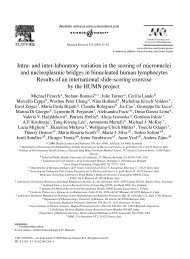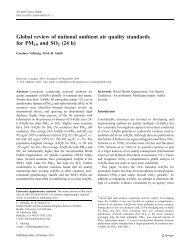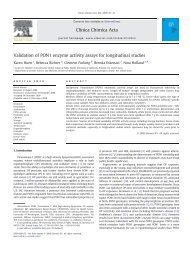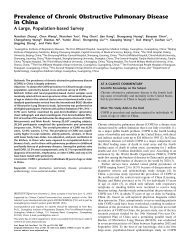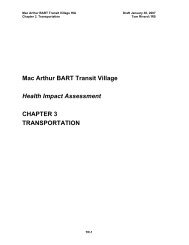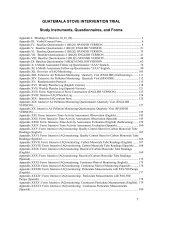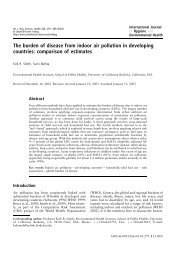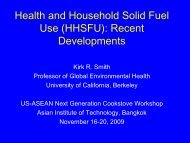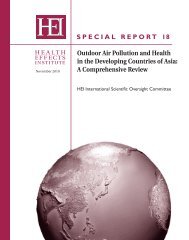Indoor air pollution from solid fuels and risk of low birth weight and ...
Indoor air pollution from solid fuels and risk of low birth weight and ...
Indoor air pollution from solid fuels and risk of low birth weight and ...
- No tags were found...
You also want an ePaper? Increase the reach of your titles
YUMPU automatically turns print PDFs into web optimized ePapers that Google loves.
AcknowledgementWHO wishes to thank Nigel Bruce, Division <strong>of</strong> Public Health, University <strong>of</strong> Liverpool,Liverpool, UK, for convening the symposium <strong>and</strong> coordinating the overall writing <strong>of</strong> thereport, <strong>and</strong> Lisa Thompson, Department <strong>of</strong> Environmental Health Sciences, University<strong>of</strong> California, Berkeley, CA, USA; Vinod Mishra, Demographic <strong>and</strong> Health ResearchDivision, ORC Macro, Calverton, MD, USA; Amna Rehana Siddiqui, Department <strong>of</strong>Community Health Sciences, Aga Khan University, Karachi, Pakistan; Tracey Woodruff,U.S. Environmental Protection Agency, Washington, DC, USA; <strong>and</strong> Dan PopeDivision <strong>of</strong> Public Health, University <strong>of</strong> Liverpool, Liverpool, UK for contributing data<strong>and</strong> chapters to the repeot <strong>and</strong> for contributing to the overall summary.The symposium was supported by the Department <strong>of</strong> Child <strong>and</strong> Adolescent Health <strong>and</strong>Development, WHO, Geneva, Switzerl<strong>and</strong>, with funds made available through theU.S. Agency for International Development (USAID).iv<strong>Indoor</strong> <strong>air</strong> <strong>pollution</strong> <strong>from</strong> <strong>solid</strong> <strong>fuels</strong> <strong>and</strong> <strong>risk</strong> <strong>of</strong> <strong>low</strong> <strong>birth</strong> <strong>weight</strong> <strong>and</strong> still<strong>birth</strong>
Executive summaryIntroductionAround half <strong>of</strong> the world’s population still relies on <strong>solid</strong> <strong>fuels</strong> for everyday energyneeds, 2.4 billion on biomass (wood, animal dung, crop wastes) <strong>and</strong> 0.6 billion oncoal. These <strong>fuels</strong> are typically used indoors or in partly enclosed cooking areas, burntin poorly vented, inefficient stoves, <strong>and</strong> leading to very high levels <strong>of</strong> exposure to smokewhich contains products <strong>of</strong> incomplete combustion. Most heavily exposed are women<strong>of</strong> child-bearing age <strong>and</strong> young children. Women usually continue with their domestic<strong>and</strong> cooking role throughout pregnancy, so the developing foetus is also indirectlyexposed. Studies <strong>of</strong> urban <strong>air</strong> <strong>pollution</strong> <strong>and</strong> environmental tobacco smoke (ETS) haveshown that several combustion pollutants – including carbon monoxide <strong>and</strong> small particles– are linked to adverse pregnancy outcomes; still <strong>birth</strong>s <strong>and</strong> <strong>low</strong> <strong>birth</strong> <strong>weight</strong>.These pollutants are also prominent in smoke <strong>from</strong> <strong>solid</strong> fuel used in developing countryhomes, so there is good reason to expect that this exposure may also impact onpregnancy outcomes in these settings. This report summarises the evidence linkingsuch exposure to <strong>low</strong> <strong>birth</strong> <strong>weight</strong> (LBW) <strong>and</strong> still<strong>birth</strong>, as reviewed in a symposiumheld at ISEE 2005 in Johannesburg.MethodsRepresentatives <strong>of</strong> research groups which have carried out recent studies <strong>of</strong> biomasssmoke <strong>pollution</strong> <strong>and</strong> LBW <strong>and</strong>/or still<strong>birth</strong> in developing countries were invited topresent their findings at the symposium. In addition, recent work on ambient <strong>air</strong> <strong>pollution</strong><strong>and</strong> LBW <strong>from</strong> the state <strong>of</strong> California was also represented. Key issues for futurestudies were identified. Fol<strong>low</strong>ing the symposium, a preliminary literature review wasconducted using PubMed: combining exposure <strong>and</strong> outcome terms yielded 190 studies,<strong>of</strong> which 44 were retained as relevant for review <strong>of</strong> abstracts. This, together with furthercontact with researchers in the field, provided only one new study which is included inthis review. Data has been extracted, <strong>and</strong> quality assessed by one author (NB).Results(i) Low <strong>birth</strong> <strong>weight</strong>Five studies are included: one cross-sectional survey, two cohort studies, one casecontrolstudy <strong>and</strong> one r<strong>and</strong>omised controlled trial. Differences in exposure wereexpressed as biomass vs. clean fuel for four studies, <strong>and</strong> biomass in open fires vs. ventilated(chimney) stoves in one. The timing <strong>of</strong> <strong>birth</strong> <strong>weight</strong> measurement varied betweenExecutive summary
studies, <strong>and</strong> only two assessed gestational age. For mean <strong>birth</strong> <strong>weight</strong>, the range <strong>of</strong> differencesfor ‘high’ vs. ‘<strong>low</strong>’ exposure across four studies were <strong>from</strong> 59 to 175 gm <strong>low</strong>er<strong>weight</strong> with the higher exposure. All estimates were adjusted, <strong>and</strong> three were statisticallysignificant. For % LBW (defined as
1 IntroductionBackgroundNearly half <strong>of</strong> the world’s population, some 3 billion people, rely on <strong>solid</strong> <strong>fuels</strong> (wood,animal dung, crop residues, <strong>and</strong> coal) for their everyday household energy needs. Much<strong>of</strong> this fuel is burned in open fires <strong>and</strong> simple stoves with inadequate ventilation, causingvery high levels <strong>of</strong> smoke exposure – particularly for women <strong>and</strong> young children. AWHO Comparative Risk Assessment report estimated that this exposure is responsiblefor around 1.5 million excess deaths annually (2;3). This estimate, based on reliableevidence <strong>of</strong> health outcomes, was restricted to acute <strong>low</strong>er respiratory infections inchildren up to 5 years <strong>and</strong> chronic obstructive lung disease in adults, as well as lungcancer in adults in places where only coal was used. However, emerging evidence showsthat household <strong>air</strong> <strong>pollution</strong> increases the <strong>risk</strong> <strong>of</strong> other important conditions, includingtuberculosis, asthma, cataract, <strong>low</strong> <strong>birth</strong> <strong>weight</strong> (LBW) <strong>and</strong> perinatal mortality,although only a few studies have been published for these health outcomes (2;4).This report, based on the ISEE 2005 symposium, focuses on the links between <strong>pollution</strong>due to <strong>solid</strong> fuel use <strong>and</strong> <strong>birth</strong> <strong>weight</strong>, still<strong>birth</strong> <strong>and</strong> mortality. At the time <strong>of</strong> preparation,we were aware <strong>of</strong> only two published studies <strong>from</strong> developing countries on indoor<strong>air</strong> <strong>pollution</strong> <strong>and</strong> <strong>birth</strong> <strong>weight</strong>, <strong>and</strong> only one linking this exposure to still<strong>birth</strong>s.Since pregnant women in countries with high rates <strong>of</strong> (i) <strong>solid</strong> fuel use <strong>and</strong> (ii) LBW<strong>and</strong> perinatal mortality are rarely able to avoid exposing themselves <strong>and</strong> their unbornchildren to household <strong>air</strong> <strong>pollution</strong> <strong>from</strong> cooking <strong>and</strong> other activities, even a modestincrease in relative <strong>risk</strong> for these conditions could translate into a substantial <strong>risk</strong> for thepopulation. LBW remains a very important <strong>risk</strong> factor for pneumonia <strong>and</strong> other seriousadverse health outcomes for infants in developing countries.Aims <strong>and</strong> objectives• To review <strong>and</strong> summarize the current <strong>and</strong> emerging evidence for links betweenindoor <strong>air</strong> <strong>pollution</strong> <strong>from</strong> <strong>solid</strong> fuel use <strong>and</strong> <strong>low</strong> <strong>birth</strong> <strong>weight</strong> <strong>and</strong> perinatal mortality.• To identify research to confirm what is already known.• To consider appropriate research designs <strong>and</strong> settings to meet identified researchneeds.• To initiate planning in respect <strong>of</strong> (a) methods <strong>and</strong> (b) possible settings to assist thedevelopment <strong>of</strong> proposals for future research to guide policy on child health.1. Introduction
Intended outcomesFor researchers on indoor <strong>air</strong> <strong>pollution</strong> <strong>and</strong> child health, this symposium took stock <strong>of</strong>what is known about the <strong>risk</strong> <strong>of</strong> LBW <strong>and</strong> perinatal mortality (for which the evidence isplausible but still limited) <strong>and</strong> identifies key research priorities. A subsequent workshopwill discuss methodological issues to advance the research agenda, <strong>and</strong> will identifypotential research collaboration <strong>and</strong> study settings.This article summarizes the studies given at the symposium (in section 2), presents theevidence in tabular form <strong>from</strong> studies in developing countries (in section 3), <strong>and</strong> concludeswith ideas for further research identified during discussions at a workshop thatfol<strong>low</strong>ed the symposium (section 4).<strong>Indoor</strong> <strong>air</strong> <strong>pollution</strong> <strong>from</strong> <strong>solid</strong> <strong>fuels</strong> <strong>and</strong> <strong>risk</strong> <strong>of</strong> <strong>low</strong> <strong>birth</strong> <strong>weight</strong> <strong>and</strong> still<strong>birth</strong>
2 Symposium presentationsSummaries <strong>of</strong> the five presentations at the symposiumare given in this section.2.1 Low <strong>birth</strong> <strong>weight</strong> among a cohort <strong>of</strong> Guatemalan children: indoor <strong>air</strong><strong>pollution</strong> as a contributing factorLisa Thompson (1), Nigel Bruce (2), Alisa Jenny (1), Anaite Diaz (3), Byron Arana (3),Robert Klein (3) & Kirk R Smith (1)(1) Environmental Health Sciences, School <strong>of</strong> Public Health, University <strong>of</strong> California, Berkeley, CA, USA(2) Division <strong>of</strong> Public Health, University <strong>of</strong> Liverpool, Liverpool, UK(3) Center for Health Studies, Universidad del Valle, Guatemala City, GuatemalaBackgroundA <strong>low</strong> <strong>birth</strong> <strong>weight</strong> (LBW) <strong>of</strong>
Methods/sampleA total <strong>of</strong> 275 women had a baseline pregnancy examination by a physician, whichincluded a medical history, urine exam, blood pressure check, <strong>and</strong> assessment <strong>of</strong> fetalgrowth (fundal height). The women were then fol<strong>low</strong>ed up weekly in their homes bytrained field workers, <strong>and</strong> were referred to a physician if any pregnancy-related warningsigns or symptoms were noted. Of these 275 women, 15 were not pregnant or were lostto fol<strong>low</strong>-up, two delivered twins, <strong>and</strong> one had a child with trisomy 21. There were fivemiscarriages <strong>and</strong> four still<strong>birth</strong>s. During the course <strong>of</strong> the study, an additional 31 “second”pregnancies were observed. A total <strong>of</strong> 286 singleton <strong>birth</strong>s monitored by projectstaff delivered in their homes, <strong>and</strong> fieldworkers attempted to visit the home as soonas possible to measure the <strong>birth</strong> <strong>weight</strong>. Birth <strong>weight</strong> monitoring began in November2002 using a scale accurate to 100 grams. Beginning in August 2003, <strong>birth</strong> <strong>weight</strong>swere measured using a SILTEC BS-1 scale, which was accurate to within 10 grams.Babies were undressed except for a light shirt provided by the project staff to st<strong>and</strong>ardizethe clothing <strong>weight</strong>. Gestational age was not assessed; 48-hour monitoring <strong>of</strong> thepregnant women was done every 3 months using Gastec passive diffusion carbon monoxide(CO) tubes. A total <strong>of</strong> 386 CO tubes were worn by pregnant women during eithertheir first or second study pregnancy. In a study by Naeher et al., passive diffusion COtubes (Draeger) were demonstrated to be a f<strong>air</strong>ly good surrogate for mothers’ personalexposure to kitchen PM2.5 (24 hour) with a Spearman correlation coefficient <strong>of</strong> 0.65(11). CO data are available for this report as PM data are not yet available.<strong>Indoor</strong> <strong>air</strong> <strong>pollution</strong> <strong>from</strong> <strong>solid</strong> <strong>fuels</strong> <strong>and</strong> <strong>risk</strong> <strong>of</strong> <strong>low</strong> <strong>birth</strong> <strong>weight</strong> <strong>and</strong> still<strong>birth</strong>ResultsExposure assessmentAll the pregnant women in the study wore a CO tube at least once during their pregnancy.The plancha group’s exposure to CO was approximately 20% <strong>low</strong>er than that forthe control open-fire group: mean (95% CI) 48-hour values were 1.97 (1.72, 2.27) <strong>and</strong>2.49 (2.09, 2.89) respectively (t-test, unequal variance, p = 0.047), as shown in Table1. First trimester exposures were monitored in “second” pregnancies but are not shownin Table 1; the reduction was greater than in the first pregnancies, <strong>and</strong> may reflect anoverall awareness about avoidance <strong>of</strong> indoor <strong>air</strong> <strong>pollution</strong> during the project. Furthermore,CO reductions were more pronounced among pregnant mothers as comparedto non-pregnant mothers who wore the CO tubes. In a multivariate regression model(results not shown), plancha status significantly reduced CO exposures by 1.52 ppm(t-test: –11.42, p
ly before, or in a few cases, after delivery. To al<strong>low</strong> for this, women were reclassifiedaccording to the first day the plancha could be used after the 35-day period needed tocondition <strong>and</strong> “dry” the stove. Under this reclassification, 29 <strong>of</strong> the plancha womenactually resided in open fire households throughout their pregnancy, <strong>and</strong> 5 <strong>of</strong> the openfirehouseholds had a second pregnancy after the plancha stove was built, thus they werereclassified as plancha households. In order to illustrate the effect <strong>of</strong> this adjustment, theresults will be presented with <strong>and</strong> without re-classification.Demographic characteristicsTable 2 provides baseline information about the participants enrolled during their“first” study pregnancy. Almost 58% <strong>of</strong> the women were in their third trimester at thetime <strong>of</strong> the initial examination, 35% were in their second trimester, <strong>and</strong> only 7% werein their first trimester. The mothers <strong>and</strong> fathers in the plancha group tended to be twoyears younger on average, <strong>and</strong> reported fewer pregnancies. There was no statisticallysignificant difference between the two groups for the number <strong>of</strong> abortions, Caesareansections or deceased children. None <strong>of</strong> the women reported a personal history <strong>of</strong> tuberculosis,diabetes, renal or heart disease. One woman reported a history <strong>of</strong> hypertension.Two <strong>of</strong> the women reported a personal history <strong>of</strong> alcoholism; 60 (23%) reportedthat an immediate family member, in most cases identified as the spouse, was an alcoholic.Eighteen (7%) <strong>of</strong> the women had a known personal history <strong>of</strong> prior anaemia.Borderline hypertension was observed in only one woman; the remaining 254 bloodpressure measurements were normotensive. Both systolic <strong>and</strong> diastolic blood pressureswere almost 2 mmHg higher in the open-fire group as compared to the plancha group,but these differences were not significant. Urine examination revealed no women withglycosuria <strong>and</strong> less than 3% with proteinuria or leukorrhoea. Average height for womenin the study was 144.6 cm. There was no monitoring <strong>of</strong> <strong>weight</strong> gain at the start <strong>of</strong> (orduring) the pregnancy.Birth <strong>weight</strong> outcomesBirth <strong>weight</strong>s <strong>of</strong> 188 out <strong>of</strong> 286 live <strong>birth</strong> newborns (65.7%) were measured within 48hours <strong>of</strong> delivery, while 225 (78.7%) were measured within one week; 1 50 (22.2%) <strong>of</strong>all measured <strong>birth</strong>s were
Table 2Demographic characteristics <strong>of</strong> participants enrolled during pregnancy, by stove type<strong>Indoor</strong> <strong>air</strong> <strong>pollution</strong> <strong>from</strong> <strong>solid</strong> <strong>fuels</strong> <strong>and</strong> <strong>risk</strong> <strong>of</strong> <strong>low</strong> <strong>birth</strong> <strong>weight</strong> <strong>and</strong> still<strong>birth</strong>Characteristic N Plancha Open fire TestMother’s age (years): 25.6 (6.7) 27.3 (6.2) T = 2.18mean (SD) 134 126 p
Table 4Birth <strong>weight</strong>, difference in grams due to plancha (unadjusted), based on actual assignmentgroup <strong>and</strong> reclassification groupStove type Plancha Difference 95% Confidence p-value(n) in grams intervalWeighed at
Table 6Multivariate model <strong>of</strong> <strong>birth</strong> <strong>weight</strong> outcome measured at 5 <strong>birth</strong>s) 175 1.83 0.07 [-13.7, 364]the <strong>risk</strong> ratios were not significant, reflecting the increased instability <strong>and</strong> <strong>low</strong> power todetect significant differences within this small sample.A multivariate model was constructed to examine other potential explanatory variablesthat might influence <strong>birth</strong> <strong>weight</strong>. These variables were included in the model basedon significance in bivariate analyses or as supported by the literature. A socioeconomicindicator (ratio <strong>of</strong> the number <strong>of</strong> economic providers to the number <strong>of</strong> household members)<strong>and</strong> whether or not the father smokes were also included in the model, but eliminatedas they did not improve the stability <strong>of</strong> the estimates, as shown in Table 6.10<strong>Indoor</strong> <strong>air</strong> <strong>pollution</strong> <strong>from</strong> <strong>solid</strong> <strong>fuels</strong> <strong>and</strong> <strong>risk</strong> <strong>of</strong> <strong>low</strong> <strong>birth</strong> <strong>weight</strong> <strong>and</strong> still<strong>birth</strong>DiscussionThe Guatemalan R<strong>and</strong>omized Intervention Stove Trial <strong>of</strong>fered a unique opportunityto monitor the health <strong>of</strong> pregnant women <strong>and</strong> subsequent perinatal outcomes in one <strong>of</strong>the poorest regions in Guatemala. There are several limiting factors to the study. First,the study was designed to examine the children’s respiratory health; among some <strong>of</strong> therecruited households with pregnant women, stove construction was not completed untilafter the child was born. Only 13 <strong>of</strong> the women had a plancha throughout their (second)pregnancies, thus limiting differential exposure to the third trimester, as most <strong>of</strong>the women would have used open fires during the first <strong>and</strong>/or second trimester. Second,methodological limitations include lack <strong>of</strong> information about maternal <strong>weight</strong> gain<strong>and</strong> nutritional factors, gestational age assessment, inability to reach all home <strong>birth</strong>swithin 48 hours, <strong>and</strong> accuracy to only 100 grams <strong>of</strong> the weighing scale used in the first10 months <strong>of</strong> the study, all <strong>of</strong> which could bias the findings toward the null. Third,although plancha stoves reduced women’s personal exposures to CO, there were otherimportant exposures to IAP that could potentially affect a pregnant woman. Roughly80% <strong>of</strong> the study population were using the temascal, a sauna bath used for hygiene <strong>and</strong>bathing once or twice a week. Unpublished data <strong>from</strong> a sub-sample <strong>of</strong> this populationsuggest average carbon monoxide exposure levels during temascal use to be 810 ppmhr/weekfor women <strong>of</strong> reproductive age (12). The carbon monoxide data presented inthis report did not incorporate these significantly elevated sauna bath exposures, whichmay have contributed to the high incidence <strong>of</strong> <strong>low</strong> <strong>birth</strong> <strong>weight</strong> among temascal users.At 22.2%, LBW incidence in the current study is much higher than the national reportedincidence. This is most likely to be due to intensive surveillance during the study,which increased the ability to detect LBW <strong>and</strong> may reflect more accurate data thancollected by national statistics. The study’s field personnel devised a notification system<strong>and</strong> arranged for a fieldworker to visit homes to measure <strong>birth</strong> <strong>weight</strong> within 48 hours.Twenty-one percent <strong>of</strong> <strong>birth</strong>s in the study remained unmeasured, but as the population
is extremely homogeneous, the unknown <strong>birth</strong> <strong>weight</strong>s were probably similar to theknown <strong>birth</strong> <strong>weight</strong>s. National survey data estimated that 22% <strong>of</strong> Guatemalan <strong>birth</strong><strong>weight</strong>s are unmeasured, <strong>and</strong> the general population in the region is likely to be similarto the group <strong>of</strong> women who were monitored during the study women <strong>and</strong> childrenwho are under-represented <strong>and</strong> uncounted in the national surveys. Finally, the samplesize is too small to detect a significant difference. Despite the limitations, the presentresults demonstrate a weak, but consistent, relationship between stove type, as a proxyfor exposure to CO, <strong>and</strong> increased LBW among this very vulnerable population.AcknowledgementsWe acknowledge the assistance <strong>and</strong> cooperation <strong>of</strong> the Guatemalan fieldworkers <strong>and</strong>study participants as well as the Guatemala Ministry <strong>of</strong> Health, <strong>and</strong> funding by theUS National Institute <strong>of</strong> Environmental Health Sciences (NIEHS #R01ES010178), theWorld Health Organization, Geneva, <strong>and</strong> the AC Griffin Family Trust.2.2 Preliminary analyses <strong>of</strong> indoor <strong>air</strong> <strong>pollution</strong> <strong>and</strong> <strong>low</strong> <strong>birth</strong> <strong>weight</strong>(LBW) in Southern PakistanAmna Rehana Siddiqui (1), Ellen B. Gold (2), Kenneth H. Brown (3), Kiyoung Lee (4) &Zulfiqar Bhutta (5)(1) Department <strong>of</strong> Community Health Sciences, Aga Khan University, Karachi, Pakistan(2) Department <strong>of</strong> Public Health Sciences, University <strong>of</strong> California (UC) Davis, USA(3) Program in International Nutrition, UC Davis, USA(4) College <strong>of</strong> Public Health, University <strong>of</strong> Kentucky, USA(5) Department <strong>of</strong> Pediatrics, Aga Khan University, Karachi, PakistanBackgroundMore than 21% <strong>of</strong> infants born in Pakistan are <strong>of</strong> <strong>low</strong> <strong>birth</strong> <strong>weight</strong> (LBW) or 53%) <strong>and</strong> overall biomass use including wood, crop residues,<strong>and</strong> animal dung is >70% (21). In developing country settings, nutritional, reproductive<strong>and</strong> socioeconomic factors are considered to be the main factors responsible forLBW (22). Recent reports <strong>from</strong> developing countries (Guatemala, Zimbabwe) havedescribed an association between LBW <strong>and</strong> the use <strong>of</strong> biomass <strong>fuels</strong> in open fires forcooking (5;6). In addition, analyses <strong>from</strong> the Second National Family Health Survey<strong>of</strong> India (1998–99) reported the occurrence <strong>of</strong> still<strong>birth</strong>s related to the use <strong>of</strong> biomasscooking fuel (1). All these studies relied on the use <strong>of</strong> wood or biomass fuel as a proxyfor directly measured exposures to indoor <strong>air</strong> <strong>pollution</strong> (IAP). We present the results<strong>of</strong> preliminary analyses <strong>of</strong> pregnancy outcomes in relation to cooking fuel use amongwomen in rural, semi-rural <strong>and</strong> semi-urban communities in Sindh province, southernPakistan.2. Symposium Presentations11
Participants <strong>and</strong> methodsA total <strong>of</strong> 1404 pregnant women were enrolled through a maternal child health surveillanceprogramme <strong>from</strong> communities in Nara, Kotdiji <strong>and</strong> Bilal colonies. Kotdiji <strong>and</strong>Nara are situated some 400 km <strong>from</strong> Karachi, while Bilal colony is 50 km <strong>from</strong> Karachi.Kotdiji has both rural <strong>and</strong> urban areas, Nara is primarily rural, <strong>and</strong> Bilal colony ismostly urban. Over 80% <strong>of</strong> households in Kotdiji, more than 90% in Nara, <strong>and</strong> about15% in Bilal colony used wood as the main cooking fuel at the time <strong>of</strong> the study. Naturalgas (NG) was supplied by pipe to registered customers <strong>and</strong> others who informallyshared these points <strong>of</strong> access. Women who were pregnant in 2000 <strong>and</strong> 2001 were identifiedwith the help <strong>of</strong> lady health workers <strong>from</strong> the government-based National HealthProgramme. These women were fol<strong>low</strong>ed up monthly throughout their pregnancy bythe study’s field workers to determine the outcome <strong>of</strong> the pregnancy. The outcomeswere recorded in a questionn<strong>air</strong>e <strong>and</strong> in a log kept at the health centre after verificationby field supervisors. Children were weighed on infant scales, <strong>and</strong> when these were notavailable the infants were weighed with the mother on a bathroom scale, then subtractingthe mother’s <strong>weight</strong>. Gestational age was available for only a few subjects <strong>and</strong> wastherefore not included in the analyses.12<strong>Indoor</strong> <strong>air</strong> <strong>pollution</strong> <strong>from</strong> <strong>solid</strong> <strong>fuels</strong> <strong>and</strong> <strong>risk</strong> <strong>of</strong> <strong>low</strong> <strong>birth</strong> <strong>weight</strong> <strong>and</strong> still<strong>birth</strong>ResultsOf the total <strong>of</strong> 1404 pregnant women studied, 8% (n=112) moved out <strong>of</strong> the studyarea <strong>and</strong> 13% (n=182) refused to participate. Reproductive loss through miscarriageoccurred in 1.7% <strong>and</strong> through still<strong>birth</strong> in 7.7% <strong>of</strong> the 1102 women for whom we hadcomplete fol<strong>low</strong>-ups <strong>of</strong> pregnancy.Among the users <strong>of</strong> wood fuel, 2.4% reported a miscarriage compared to 1.1% amongnatural gas users (Fig. 1). Still<strong>birth</strong>s occurred in 10.2% <strong>of</strong> pregnant women who usedwood compared to 4.8% <strong>of</strong> NG users (crude OR=2.28, 95%CI=1.34, 3.90). The association<strong>of</strong> wood use with still<strong>birth</strong> persisted after accounting for the effect <strong>of</strong> rural-urbanlocation (adjusted OR= 1.90, 95%CI=1.10, 3.20).Birth <strong>weight</strong> data were available for 941 women, 53% <strong>of</strong> whom used wood as cookingfuel during pregnancy. Overall, LBW (
Table 1Results <strong>of</strong> multiple logistic regression showing odds ratios (95% confidence intervals)for <strong>low</strong> <strong>birth</strong> <strong>weight</strong> in relation to wood fuel versus gas, <strong>and</strong> other variablesincluded in the analysisPredictor variable Comparison Odds ratio 95% CIWood fuel Natural gas 1.77 1.2 – 2.5Mother’s BMI Per kg/m 2 0.91 0.87 – 0.95Gravida status Per unit 0.93 0.87 – 0.99Prenatal vaccine No vaccine 0.42 0.24 – 0.74SES score ≤ median SES score > median 1.07 0.73 – 1.55Rural location Urban 1.09 0.74 – 1.60<strong>of</strong> house construction, house ownership, <strong>and</strong> housing density (occupants per room),such that a higher socioeconomic status had a high score. A multiple logistic regressionmodel was used to address confounding by the median level <strong>of</strong> the SES score <strong>and</strong> otherfactors: in this analysis, wood fuel was associated with an increased <strong>risk</strong> <strong>of</strong> LBW (OR1.77, 95%CI=1.2-2.5), after adjusting for other variables in Table 1.Birth <strong>weight</strong> data were available for 465 out <strong>of</strong> 641 women who also had blood drawnfor serum vitamin A levels (µg/dl). Those who had blood samples drawn did not differ<strong>from</strong> other study participants by socioeconomic status, rural-urban location, gravidastatus, <strong>and</strong> other characteristics. Addition <strong>of</strong> serum vitamin A levels to the multivariatemodel above showed an independent effect <strong>of</strong> increasing vitamin A levels (adjustedOR=0.96, 95%CI=0.95-0.98) per unit (µg/dl) on LBW, while the association <strong>of</strong> woodfuel use with LBW persisted (adjusted OR=1.78, 95%CI=1.03-3.09).<strong>Indoor</strong> <strong>air</strong> <strong>pollution</strong> levelsIn a separate pilot study, <strong>air</strong> concentrations for carbon monoxide (CO) <strong>and</strong> particulatematter (PM)
ConclusionFindings <strong>from</strong> these preliminary analyses suggest an independent effect <strong>of</strong> indoor <strong>air</strong><strong>pollution</strong> <strong>from</strong> open wood fires used for cooking on <strong>birth</strong> <strong>weight</strong> <strong>and</strong> still<strong>birth</strong>. Confoundingby rural/urban location <strong>and</strong> socioeconomic status can be difficult to accountfor fully, due to the correlation between <strong>low</strong>er socioeconomic status <strong>and</strong> use <strong>of</strong> wood asfuel. Urban <strong>and</strong> rural areas in this setting differed by the type <strong>of</strong> cooking fuel, as themajority <strong>of</strong> households in rural areas used wood. In the presence <strong>of</strong> inadequate nutrition,increasing gravidity, <strong>and</strong> poor health care access, the effects <strong>of</strong> maternal prenatalexposure to indoor <strong>air</strong> <strong>pollution</strong> <strong>from</strong> the use <strong>of</strong> biomass cooking fuel in Pakistan couldbe an additional factor for poor obstetric outcomes.2.3 Maternal exposure to biomass smoke <strong>and</strong> reduced <strong>birth</strong> <strong>weight</strong>in Zimbabwe 1Vinod Mishra (1), Xiaolei Dai (2), Kirk R. Smith (3) & Lasten Mika (4)(1) Demographic <strong>and</strong> Health Research Division, ORC Macro, Calverton, MD, USA(2) Manpower Demonstration Research Corporation, New York, USA(3) Environmental Health Sciences, School <strong>of</strong> Public Health, University <strong>of</strong> California, Berkeley, CA, USA(4) Intermediate Technology Development Group Southern Africa, Harare, Zimbabwe14<strong>Indoor</strong> <strong>air</strong> <strong>pollution</strong> <strong>from</strong> <strong>solid</strong> <strong>fuels</strong> <strong>and</strong> <strong>risk</strong> <strong>of</strong> <strong>low</strong> <strong>birth</strong> <strong>weight</strong> <strong>and</strong> still<strong>birth</strong>IntroductionReliance on biomass for cooking <strong>and</strong> heating exposes many women in developing countriesto high levels <strong>of</strong> many health-damaging <strong>air</strong> pollutants indoors. Numerous studieshave linked exposure to tobacco smoke (both active smoking by mothers <strong>and</strong> environmentaltobacco smoke) <strong>and</strong> ambient <strong>air</strong> <strong>pollution</strong> to intrauterine growth retardation<strong>and</strong> reduced <strong>birth</strong> <strong>weight</strong>, <strong>of</strong>ten at <strong>pollution</strong> levels substantially <strong>low</strong>er than typicallyfound in biomass-burning homes.Biomass combustion in simple, inefficient cooking stoves in poorly ventilated conditionscauses heavy exposures to CO, which binds to haemoglobin, forms carboxyhaemoglobin,<strong>and</strong> reduces the oxygen-carrying capacity <strong>of</strong> blood. A developing fetus,deprived <strong>of</strong> adequate oxygen, suffers intrauterine growth retardation <strong>and</strong> an increased<strong>risk</strong> <strong>of</strong> reduced <strong>birth</strong> <strong>weight</strong>. Particulate matter <strong>and</strong> other pollutants (e.g. polycyclicaromatic hydrocarbons) in biomass smoke can also increase the <strong>risk</strong> <strong>of</strong> intrauterinegrowth retardation <strong>and</strong> reduced <strong>birth</strong> <strong>weight</strong> by reducing the mother’s lung function<strong>and</strong> increasing the <strong>risk</strong> <strong>of</strong> maternal chronic <strong>and</strong> acute respiratory disease, which alsoreduces oxygen delivery to the fetus (see Fig. 1).Although there are good reasons to expect adverse effects <strong>of</strong> biomass smoke exposureon pregnancy outcomes, only one study, in rural Guatemala, reported an associationbetween bi<strong>of</strong>uel use <strong>and</strong> reduced <strong>birth</strong> <strong>weight</strong> (5). In the present study, we examine theassociation between household use <strong>of</strong> biomass <strong>fuels</strong> (wood, dung, or straw) <strong>and</strong> reduced<strong>birth</strong> <strong>weight</strong> using data <strong>from</strong> a national health survey in Zimbabwe. Data <strong>from</strong> Zimbabweprovide an excellent opportunity to examine this association because, unlike mostdeveloping country situations where a large majority <strong>of</strong> deliveries take place at home<strong>and</strong> only a small proportion <strong>of</strong> children are weighed at <strong>birth</strong>, three-quarters <strong>of</strong> the childrenin Zimbabwe are born in a health facility <strong>and</strong> are weighed at <strong>birth</strong>.1The full paper has been published in Annals <strong>of</strong> Epidemiology 2004; 14(10):740–7. For a copy, pleasecontact Vinod Mishra (vinod.mishra@orcmacro.com).
Fig. 1Possible mechanisms by which exposure to cooking smoke <strong>and</strong> tobacco smoke mightcause adverse pregnancy outcomes. Source: revised <strong>from</strong> (1)CarbonmonoxideSmoke exposureCooking smokeTobacco smoke(active & passive)Particulate matter<strong>and</strong> other pollutantsReduced oxygen inmother’s bloodReduced maternallung function <strong>and</strong>other lung diseaseReducedoxygen delivery tothe placentaReducedoxygen delivery tothe placentaReducednutritional intake <strong>and</strong>reduced nuttrientdelivery to the fetusImp<strong>air</strong>ed fetal growth,increased <strong>risk</strong> <strong>of</strong> still <strong>birth</strong>,reduced <strong>birth</strong> <strong>weight</strong>, <strong>and</strong>other adverse pregnancyoutcomesMethodsAnalysis in this study is based on information on 3559 child<strong>birth</strong>s during the five yearspreceding the 1999 Zimbabwe Demographic <strong>and</strong> Health Survey. The survey collecteddemographic, socioeconomic, <strong>and</strong> health information <strong>from</strong> a nationally representativeprobability sample <strong>of</strong> 6369 households, representing all 10 provinces. The sample is atwo-stage cluster sample with an overall response rate <strong>of</strong> 97.8%. For each <strong>birth</strong> duringthe five years preceding the survey, the mother was asked if the child had been weighedat the time <strong>of</strong> <strong>birth</strong>. For those weighed at <strong>birth</strong>, the mother was asked to show thehealth card, <strong>and</strong> the <strong>birth</strong> <strong>weight</strong> was recorded (in grams) <strong>from</strong> the card. For motherswho did not have the card, the <strong>birth</strong> <strong>weight</strong> was recorded based on the mother’s recall.The survey also asked about the main cooking fuel – wood, dung, straw, charcoal,kerosene, electricity, liquid petroleum gas (LPG)/natural gas, <strong>and</strong> a residual category <strong>of</strong>other <strong>fuels</strong>. Information on fuel types was used to group households into three categoriesrepresenting the extent <strong>of</strong> exposure to cooking smoke – high <strong>pollution</strong> <strong>fuels</strong> (wood,dung, or straw), medium <strong>pollution</strong> <strong>fuels</strong> (kerosene or charcoal), <strong>and</strong> <strong>low</strong> <strong>pollution</strong> <strong>fuels</strong>(LPG/natural gas or electricity). Households using the medium <strong>pollution</strong> <strong>fuels</strong> <strong>and</strong> theresidual category <strong>of</strong> other <strong>fuels</strong> (11%) were excluded <strong>from</strong> the analysis.A number <strong>of</strong> generalized linear models were estimated using the SURVEYREG procedurein the SAS System. Control variables included the child’s sex <strong>and</strong> <strong>birth</strong> order,<strong>and</strong> the mother’s age at child<strong>birth</strong>, body mass index (BMI), whether she received ironsupplementation or any drug for malaria during the pregnancy, her religion <strong>and</strong> educationin completed years, household st<strong>and</strong>ard <strong>of</strong> living, <strong>and</strong> region <strong>of</strong> residence. Becauseinformation on pregnancy care (iron supplementation <strong>and</strong> malaria drugs during pregnancy)was collected only for the last <strong>birth</strong> in the 5-year period preceding the survey,multivariate analysis was limited only to the last <strong>birth</strong>s. The survey found that very fewmothers in the sample smoked tobacco (0.7%); information on smoking by other familymembers was not obtained.2. Symposium Presentations15
A <strong>weight</strong>ing factor was applied to all observations to compensate for over-sampling <strong>of</strong>certain categories <strong>of</strong> respondents in the study design. Results are presented as mean<strong>birth</strong> <strong>weight</strong> estimates with significance levels <strong>and</strong> 95% confidence intervals for categories<strong>of</strong> each predictor variable by holding other variables constant at their mean values.Estimation <strong>of</strong> st<strong>and</strong>ard errors takes into account design effects due to clustering at thelevel <strong>of</strong> the primary sampling unit.ResultsIt was found that 78% <strong>of</strong> all children born during the five years preceding the surveywere weighed at <strong>birth</strong>. Children who were not weighed at <strong>birth</strong> were considerablymore likely to be <strong>from</strong> households using biomass fuel, compared to those who wereweighed at <strong>birth</strong> (91% <strong>and</strong> 59%, respectively, using biomass fuel). Health cards wereavailable for 53% <strong>of</strong> the children who were weighed at <strong>birth</strong>. For the remaining 47%,the mother reported the <strong>birth</strong> <strong>weight</strong> <strong>from</strong> recall. Children in poorer households <strong>and</strong>in households using high <strong>pollution</strong> <strong>fuels</strong> were slightly more likely to have health cardsavailable at the time <strong>of</strong> the survey, compared with children in more affluent households<strong>and</strong> in households using cleaner <strong>fuels</strong>. Among children weighed at <strong>birth</strong>, only 8% were<strong>of</strong> <strong>low</strong> <strong>birth</strong> <strong>weight</strong> (≤2500 g). Slightly more had <strong>low</strong> <strong>birth</strong> <strong>weight</strong> in the biomass fuelhouseholds (8.6%) than in the cleaner fuel households (7.7%), a non-significant difference.The mean <strong>birth</strong> <strong>weight</strong> <strong>of</strong> children born in the past five years who were weighedat <strong>birth</strong> was 3140 g (95%CI: 3119, 3161). Children whose <strong>birth</strong> <strong>weight</strong>s were based onmother’s recall (3174 g) were heavier than those whose <strong>birth</strong> <strong>weight</strong>s were <strong>from</strong> healthcards (3111 g).With other factors controlled, babies born to mothers cooking with wood, dung, orstraw were 175 g lighter (95%CI: -300, -50), on average, compared with babies born tomothers using LPG, natural gas, or electricity. The difference was 120 g (95%CI: -301,61) for children whose <strong>birth</strong> <strong>weight</strong>s were taken <strong>from</strong> health cards, <strong>and</strong> 183 g (95%CI:-376, 10) for children whose <strong>birth</strong> <strong>weight</strong>s were reported by the mothers.16<strong>Indoor</strong> <strong>air</strong> <strong>pollution</strong> <strong>from</strong> <strong>solid</strong> <strong>fuels</strong> <strong>and</strong> <strong>risk</strong> <strong>of</strong> <strong>low</strong> <strong>birth</strong> <strong>weight</strong> <strong>and</strong> still<strong>birth</strong>ConclusionsIt is notable in this study <strong>from</strong> Zimbabwe that the proportion <strong>of</strong> <strong>birth</strong>s be<strong>low</strong> 2500 g(8%) is considerably <strong>low</strong>er <strong>and</strong> the mean <strong>birth</strong> <strong>weight</strong> (3140 g) higher than in manydeveloping countries. The results indicate that household use <strong>of</strong> high <strong>pollution</strong> cooking<strong>fuels</strong> may cause reduced <strong>birth</strong> <strong>weight</strong>. Maternal smoking is not likely to be a significantcontributing factor because only 0.7% <strong>of</strong> mothers reported smoking tobacco. Thestudy could not assess the effect <strong>of</strong> passive smoking because the survey did not collectinformation on smoking by other family members. The relationship needs to be furtherinvestigated using more direct measures <strong>of</strong> smoke exposure <strong>and</strong> <strong>birth</strong> <strong>weight</strong> <strong>and</strong> takingaccount <strong>of</strong> exposures to passive tobacco smoking. Such research is important becausea large proportion <strong>of</strong> households in Zimbabwe <strong>and</strong> other developing countries rely onbiomass <strong>fuels</strong> for household energy <strong>and</strong> <strong>low</strong> <strong>birth</strong> <strong>weight</strong> is a known <strong>risk</strong> factor for illhealth <strong>and</strong> death in young children.
2.4 Cooking fuel <strong>and</strong> tobacco smoke as <strong>risk</strong> factors for still<strong>birth</strong> 1Vinod Mishra (1), Robert D. Retherford (2) & Kirk R. Smith (3)(1) Demographic <strong>and</strong> Health Research Division, ORC Macro, Calverton, MD, USA(2) East-West Center, Honolulu, Hawaii, USA(3) Environmental Health Sciences, School <strong>of</strong> Public Health, University <strong>of</strong> California, Berkeley, CA, USAIntroductionNumerous studies have linked tobacco smoke (both active smoking by the mother<strong>and</strong> environmental tobacco smoke) <strong>and</strong> ambient <strong>air</strong> <strong>pollution</strong> to adverse pregnancyoutcomes. Although smoke <strong>from</strong> biomass combustion produces some <strong>of</strong> the same pollutantsfound in tobacco smoke <strong>and</strong> ambient <strong>air</strong>, only one study has linked cookingwith biomass <strong>fuels</strong> during pregnancy to still<strong>birth</strong>s (23), <strong>and</strong> two recent studies, in Zimbabwe<strong>and</strong> in rural Guatemala, have linked it to reduced <strong>birth</strong> <strong>weight</strong> (5;6). This studyexamines the association between household use <strong>of</strong> biomass <strong>fuels</strong> (wood, dung, or cropresidues), tobacco smoking (both active <strong>and</strong> passive) <strong>and</strong> the <strong>risk</strong> <strong>of</strong> still<strong>birth</strong> using data<strong>from</strong> a large national family health survey in India.The primary mechanism by which biomass smoke may cause still<strong>birth</strong> is through exposureto carbon monoxide (CO). As in the case <strong>of</strong> tobacco smoke, biomass combustionin simple, poorly vented cooking stoves produces large volumes <strong>of</strong> CO, which binds tohaemoglobin <strong>and</strong> forms carboxyhaemoglobin. This reduces the capacity <strong>of</strong> the bloodto carry oxygen to the body tissues. A developing fetus, deprived <strong>of</strong> adequate oxygen,suffers intrauterine growth retardation <strong>and</strong> increased <strong>risk</strong> <strong>of</strong> perinatal mortality. Particulatematter <strong>and</strong> other pollutants (e.g. polycyclic aromatic hydrocarbons) in biomasssmoke can also increase the <strong>risk</strong> <strong>of</strong> an adverse pregnancy outcome by reducing themother’s lung function <strong>and</strong> increasing the <strong>risk</strong> <strong>of</strong> maternal chronic <strong>and</strong> acute respiratorydisease, which also reduces oxygen delivery to the fetus.MethodsData are <strong>from</strong> the 1998–99 Indian National Family Health Survey, which collecteddemographic, socioeconomic <strong>and</strong> health information <strong>from</strong> a nationally representativeprobability sample <strong>of</strong> 92 486 households. All states <strong>of</strong> India are represented in the sample,covering more than 99% <strong>of</strong> the country’s population. The sample is a multi-stagecluster sample with an overall response rate <strong>of</strong> 98%. The survey collected complete <strong>birth</strong>histories, including information on still<strong>birth</strong>s, <strong>from</strong> all 90,303 ever-married womenaged 15–49 years included in the survey. Separate questions were asked about inducedabortion <strong>and</strong> spontaneous abortion (i.e. miscarriage or delivery <strong>of</strong> a dead baby before28 weeks). In order to minimize recall lapse, the women were asked about still<strong>birth</strong>sseparately for each <strong>birth</strong> interval (including open <strong>birth</strong> intervals at both ends). The principalanalysis in this study is based on 19,189 ever-married women aged 40–49 withcompleted <strong>birth</strong> histories.The survey also collected information on primary <strong>and</strong> secondary <strong>fuels</strong> used for cookingor heating, using a ten-fold classification <strong>of</strong> <strong>fuels</strong> – wood, crop residues, dung cakes, coal/coke/lignite, charcoal, kerosene, electricity, liquid petroleum gas, biogas, <strong>and</strong> a residualcategory <strong>of</strong> other <strong>fuels</strong>. This information on cooking <strong>and</strong> heating <strong>fuels</strong> is used to categorizethe extent <strong>of</strong> exposure to cooking smoke – high exposure (households using onlybiomass <strong>fuels</strong>: wood, crop residues, or dung cakes), <strong>low</strong> exposure (households using onlycleaner <strong>fuels</strong>: kerosene, petroleum gas, biogas, or electricity), or medium exposure (a mix<strong>of</strong> biomass <strong>fuels</strong> <strong>and</strong> cleaner <strong>fuels</strong> or coal/coke/lignite/charcoal).1The full paper has been published in the International Journal <strong>of</strong> Environmental Health Research;15(6):397–410. For a copy, please write to Vinod Mishra (vinod.mishra@orcmacro.com).2. Symposium Presentations17
The information on current <strong>and</strong> lifetime tobacco smoking by the mother <strong>and</strong> otherhousehold members is used to categorize the extent <strong>of</strong> exposure to tobacco smoke –active smoking (mother currently smokes or has smoked regularly in the past), passivesmoking (one or more other persons in the household smoke currently), no smoking(mother has never smoked regularly <strong>and</strong> no other person in the household smokes currently).We estimated the effects <strong>of</strong> cooking smoke, measured by type <strong>of</strong> cooking fuel, <strong>and</strong>tobacco smoke (both active <strong>and</strong> passive) on the likelihood <strong>of</strong> having a still<strong>birth</strong>, usingbinary <strong>and</strong> multinomial logistic regression after controlling for a number <strong>of</strong> potentiallyconfounding factors, including mother’s anaemia status, body mass index, education,religion <strong>of</strong> household head, caste/tribe <strong>of</strong> household head, house type, availability <strong>of</strong>a separate kitchen in the house, crowding in the household, living st<strong>and</strong>ard <strong>of</strong> thehousehold, urban/rural residence, <strong>and</strong> geographic region. Estimation <strong>of</strong> the effects <strong>of</strong>cooking smoke <strong>and</strong> tobacco smoke on the likelihood <strong>of</strong> having a still<strong>birth</strong> takes intoaccount sampling <strong>weight</strong>s <strong>and</strong> design effects due to clustering at the level <strong>of</strong> the primarysampling unit.18<strong>Indoor</strong> <strong>air</strong> <strong>pollution</strong> <strong>from</strong> <strong>solid</strong> <strong>fuels</strong> <strong>and</strong> <strong>risk</strong> <strong>of</strong> <strong>low</strong> <strong>birth</strong> <strong>weight</strong> <strong>and</strong> still<strong>birth</strong>ResultsA majority (53%) <strong>of</strong> ever-married women aged 40–49 years cooked with high-<strong>pollution</strong>biomass <strong>fuels</strong>, <strong>and</strong> another 27% used biomass <strong>fuels</strong> in combination with cleaner cooking<strong>fuels</strong>. Fewer women (5%) smoked tobacco or had ever smoked tobacco regularly inthe past, but a considerable proportion <strong>of</strong> women (42%) lived in households with otheractive smokers; 7% <strong>of</strong> ever-married women aged 40–49 years reported having experienceda still<strong>birth</strong> in their lifetime.With other factors controlled, the women who cooked only with wood, dung, or cropresidues were significantly more likely to have experienced a still<strong>birth</strong> than those whocook with electricity, LPG, biogas, or kerosene (OR=1.44; 95%CI: 1.04, 1.97). Theresults also indicate that women who cooked only with biomass <strong>fuels</strong> were twice aslikely to have experienced two or more still<strong>birth</strong>s as those who cooked with cleaner <strong>fuels</strong>(RRR=2.01; 95%CI: 1.11, 3.62) – see Fig. 1. The adjusted effect <strong>of</strong> active tobacco smokingon the <strong>risk</strong> <strong>of</strong> still<strong>birth</strong> is also positive (OR=1.23) but not statistically significant. NoFig. 1Unadjusted <strong>and</strong> adjusted effects <strong>of</strong> cooking smoke (biomass <strong>fuels</strong> relative to cleaner <strong>fuels</strong>)<strong>and</strong> tobacco smoke (active smoking relative to no smoking) on the relative <strong>risk</strong> <strong>of</strong> 0, 1 <strong>and</strong>2+ still<strong>birth</strong>s (<strong>risk</strong> relative to no still<strong>birth</strong>) in India 1998–1999. Source: Mishra V et al 2005Relative <strong>risk</strong> ratio (95% Cl)76543210Cooking smokeTobacco smokeUnadjusted Adjusted Unadjusted Adjusted1.00 1.82 4.00 1.00 1.33 2.01 1.00 1.50 2.02 1.00 1.19 1.360 1 2+ 0 1 2+ 0 1 2+ 0 1 2+Number <strong>of</strong> still<strong>birth</strong>s
Low <strong>birth</strong> <strong>weight</strong> in CaliforniaWe matched PM 2.5<strong>and</strong> carbon monoxide (CO) data <strong>from</strong> <strong>air</strong> <strong>pollution</strong> monitors to<strong>birth</strong> records for singleton <strong>birth</strong>s delivered at 40 weeks gestation. Exposure was basedon <strong>pollution</strong> measurements averaged over the duration <strong>of</strong> pregnancy <strong>and</strong> for each trimester.Using logistic regression <strong>and</strong> adjusting for maternal demographic factors, wefound an adjusted odds ratio for small-for-gestational age (SGA) for exposures in thehighest compared to <strong>low</strong>est quartile <strong>of</strong> PM 2.5<strong>of</strong> 1.26 (95% CI: 1.03 to 1.50). We foundno association between CO <strong>and</strong> <strong>birth</strong> <strong>weight</strong> or SGA after controlling for maternalfactors <strong>and</strong> PM 2.5(mean <strong>birth</strong> <strong>weight</strong> difference, 2.6 g, 95% CI: -20.6 to 25.8). Thedifference in mean <strong>birth</strong> <strong>weight</strong> for infants with a 9-month exposure in the highestquartile <strong>of</strong> PM 2.5, compared to that <strong>of</strong> infants exposed in the <strong>low</strong>est quartile, was-36.1 g (95%CI: -16.5 g to -55.8); this difference was similar after controlling for CO.The findings were similar by trimester <strong>of</strong> exposure.20<strong>Indoor</strong> <strong>air</strong> <strong>pollution</strong> <strong>from</strong> <strong>solid</strong> <strong>fuels</strong> <strong>and</strong> <strong>risk</strong> <strong>of</strong> <strong>low</strong> <strong>birth</strong> <strong>weight</strong> <strong>and</strong> still<strong>birth</strong>Pre-term <strong>birth</strong>For this analysis, we used a matched case-control design. PM 2.5<strong>and</strong> CO monitoringdata were linked to California <strong>birth</strong> certificate data for singletons. County level COmeasures were used to increase the sample size <strong>and</strong> maintain a representative population.Each <strong>of</strong> the 10 673 pre-term cases was matched to 3 controls <strong>of</strong> term (39–44 week)gestation with a similar date <strong>of</strong> last menstrual period. Based on the case’s gestationalage, CO <strong>and</strong> PM 2.5exposures were calculated for total pregnancy, first month <strong>of</strong> pregnancy,<strong>and</strong> last two weeks <strong>of</strong> pregnancy. Due to the matched design, conditional logisticregression was used to adjust for maternal race/ethnicity, age, parity, marital status,<strong>and</strong> education. High PM 2.5exposure during the entire pregnancy was associated with asmall effect on pre-term <strong>birth</strong>, after adjustment for maternal factors (adjusted OR=1.15,[1.07, 1.24]). The OR did not change after adjustment for CO. Results were similar forPM 2.5exposure during the first month <strong>of</strong> pregnancy (adjusted OR=1.21, [1.12, 1.30])<strong>and</strong> the last 2 weeks <strong>of</strong> pregnancy (AOR=1.17, [1.09, 1.27]). Conversely, CO exposureat any time during pregnancy was not associated with pre-term <strong>birth</strong> (adjusted ORs<strong>from</strong> 0.95 to 1.00).Post-neonatal infant mortalityIn this analysis, we matched each postneonatal infant death to 4 infants surviving toone year <strong>of</strong> age, by <strong>birth</strong> <strong>weight</strong> <strong>and</strong> date <strong>of</strong> <strong>birth</strong> (within 2 weeks). For each matchedset, we calculated exposure as the average PM 2.5concentration over the period <strong>of</strong> lifefor the infant who died. We used conditional logistic regression to estimate the odds<strong>of</strong> post-neonatal all-cause, respiratory-related, Sudden Infant Death Syndrome (SIDS),<strong>and</strong> external causes (a control category) mortality by exposure to PM 2.5, controlling forthe matched sets <strong>and</strong> maternal demographic factors. We matched 788 post-neonatalinfant deaths to 3089 infant survivors. There were 51 post-neonatal deaths due to respiratorycauses <strong>and</strong> 120 post-neonatal deaths due to SIDS. We found an adjusted oddsratio for a 10 µg/m 3 increase in PM 2.5<strong>of</strong> 1.07 (95%CI: 0.93–1.24) for overall postneonatalmortality, 2.13 (95%CI: 1.12-4.05) for respiratory-related postneonatal mortality,0.82 (95%CI: 0.55–1.23) for SIDS, <strong>and</strong> 0.83 (95%CI: 0.50–1.39) for external causes.SummaryIn California, we found a relationship between PM 2.5<strong>and</strong> each <strong>of</strong> the perinatal outcomesevaluated. In addition, we did not identify any particular window <strong>of</strong> susceptibility for<strong>low</strong> <strong>birth</strong> <strong>weight</strong> or pre-term <strong>birth</strong>. These analyses should be evaluated in conjunctionwith the growing literature on perinatal effects <strong>and</strong> PM (particulate matter) <strong>and</strong> other
Fig. 1Adjusted odds ratios for particulate matter <strong>and</strong> measures <strong>of</strong> intra-uterine growthretardation <strong>from</strong> selected studies (7;8;26;27;36;37)1.41.31.21.11.00.90.8CzechRepublicSouthKoreaChina WE US CzechRepublicCzechRepublicCalifornia1st trimester 3rd trimester 1st trimester / 1st month 1st month 9 months* Note the increment for PM2.5 is 5 µg/m 3TSP PM 10 PM 2.5<strong>air</strong> pollutants. Fig. 1 shows the adjusted ORs <strong>from</strong> different locations around the worldfor different measurements <strong>of</strong> growth retardation, with the adjusted ORs for the exposurewindow with the highest association. As the variability in response may be due todifferences in the composition <strong>of</strong> the particulate matter in different geographic locationsor slight differences in study design, further research is warranted. The evidencesuggests an effect <strong>of</strong> particulate matter <strong>air</strong> <strong>pollution</strong> on <strong>birth</strong> <strong>weight</strong>, though thereis potential for geographic variation in the relationships <strong>and</strong> it is unclear if there is aparticular exposure window <strong>of</strong> importance. Fig. 2 presents the results for some <strong>of</strong> thestudies on infant mortality, showing f<strong>air</strong>ly consistent associations for respiratory-relatedmortality.While research remains to refine the exact nature <strong>of</strong> these relationships, prudent publicpolicy suggests that protection again potential perinatal effects is another reason t<strong>of</strong>ocus on reductions in <strong>air</strong> <strong>pollution</strong> levels.Fig. 2Adjusted odds ratios for particulate matter <strong>and</strong> post-neonatal infant mortality <strong>from</strong>selected studies for an inter-quartile range increase in particulate matter (30;32;35)2.62.42.22.01.81.61.41.21.00.8Total Resp Total Resp NonrespTotal RespKoreaCzech RepublicCaliforniaPM 10 TSP PM 2.52. Symposium Presentations21
3 Summary <strong>of</strong> evidenceMethod <strong>and</strong> search strategyTables 3.1 <strong>and</strong> 3.2 (see be<strong>low</strong>) summarize the findings <strong>from</strong> developing countries whichwere presented at the symposium. To identify published studies that were not knownto the authors, a preliminary additional search <strong>of</strong> PubMed was carried out by N.B. <strong>and</strong>D.P. using the fol<strong>low</strong>ing terms.22<strong>Indoor</strong> <strong>air</strong> <strong>pollution</strong> <strong>from</strong> <strong>solid</strong> <strong>fuels</strong> <strong>and</strong> <strong>risk</strong> <strong>of</strong> <strong>low</strong> <strong>birth</strong> <strong>weight</strong> <strong>and</strong> still<strong>birth</strong>Exposure terms• Chula (chulla, chullah)• Cooking fire• Smokeless stove, Improved stove• <strong>Indoor</strong> smoke• <strong>Indoor</strong> <strong>air</strong> <strong>pollution</strong>• Wood fuel, biomass, <strong>solid</strong> fuelOutcome terms• Birth <strong>weight</strong>• Gestational age, gestation• Intrauterine growth retardation• Neonatal mortality• Perinatal mortality• Still<strong>birth</strong>• Premature <strong>birth</strong>, premature• Pre term, preterm, pre-termCombining the exposure <strong>and</strong> outcome terms yielded 190 studies, 44 <strong>of</strong> which wereretained as relevant for review <strong>of</strong> their abstracts. Only one new report relevant to thecurrent topic was found (38), <strong>and</strong> this has been included in Table 3.1.The information in Tables 3.1 <strong>and</strong> 3.2 was compiled <strong>from</strong> the symposium papers <strong>and</strong> publishedarticles by N.B., who could contact the symposium papers’ authors for clarification.Synthesis <strong>and</strong> conclusionsA brief overview <strong>and</strong> synthesis <strong>of</strong> the results are given in this section, without a systematicreview <strong>of</strong> methodology, publication bias or heterogeneity although some commentsare made on these issues.In respect <strong>of</strong> publication bias, while only a preliminary search was made at this stageusing PubMed (see above), the matter was discussed before the symposium withresearchers active in this field, <strong>and</strong> we are not aware <strong>of</strong> any other ongoing or unpublishedstudies. Efforts will be made to identify studies <strong>and</strong> assess publication bias in thenext stage <strong>of</strong> this work.We have not yet carried out hypothesis testing for heterogeneity, but there appears to belittle evidence <strong>of</strong> this for either LBW or still<strong>birth</strong> outcomes, based on the observationthat there is no overlap in the 95% confidence intervals for the available estimates.
Some additional comments on methodological issues are presented in the fol<strong>low</strong>ing twosections which summarize the results for LBW <strong>and</strong> still<strong>birth</strong>.Low <strong>birth</strong> <strong>weight</strong>Five studies are included: one survey, two cohorts, one case-control <strong>and</strong> one r<strong>and</strong>omizedcontrolled trial. One was hospital-based (38) <strong>and</strong> four were mainly community studiesor mixed (5).Differences in exposure were expressed as biomass vs. clean fuel for four studies, <strong>and</strong>biomass in open fires vs. ventilated stoves in one study (Thompson 2006). 1 Direct exposuremeasurements were available in the latter although exposure-response relationshipshave not yet been analysed, <strong>and</strong> in a small sub-sample <strong>of</strong> homes for another study (Siddiqui2006).Measurement <strong>of</strong> <strong>birth</strong> <strong>weight</strong>s was variable owing to difficulties in obtaining accuratedata on all <strong>birth</strong>s within 1–2 days in poor countries where the majority <strong>of</strong> <strong>birth</strong>s occurat home without trained staff who measure <strong>and</strong> record <strong>birth</strong> <strong>weight</strong>s routinely for alldeliveries. The assessment <strong>of</strong> gestational age presents similar (probably greater) challenges<strong>and</strong> was available in only two <strong>of</strong> the five studies.Results are presented (or are potentially available) in two ways: (a) as differences inmean <strong>birth</strong> <strong>weight</strong>s for exposed <strong>and</strong> non-exposed persons, <strong>and</strong> (b) as differences in thepercentage <strong>of</strong> deliveries that are <strong>low</strong> <strong>birth</strong> <strong>weight</strong> (
found an adjusted <strong>risk</strong> ratio <strong>of</strong> 2.01 (1.11, 3.62) for two or more still<strong>birth</strong>s compared tozero still<strong>birth</strong>s (1).Ambient <strong>air</strong> <strong>pollution</strong> studiesEvidence <strong>from</strong> ambient <strong>pollution</strong> studies carried out in California, USA (not includedin Tables 3.1 <strong>and</strong> 3.2) shows an effect <strong>of</strong> PM2.5 on <strong>birth</strong> <strong>weight</strong> (25% increased <strong>risk</strong>,<strong>and</strong> mean difference <strong>of</strong> 36 g for the <strong>low</strong>est vs. the highest exposure groups. No independenteffect <strong>of</strong> CO on <strong>birth</strong> <strong>weight</strong> was found. A small effect <strong>of</strong> PM 2.5(15% increasein <strong>risk</strong>) was also found for pre-term <strong>birth</strong>, with again no effect <strong>of</strong> CO exposure. PM 2.5was also found to increase the <strong>risk</strong> <strong>of</strong> respiratory causes <strong>of</strong> post-neonatal mortality.24<strong>Indoor</strong> <strong>air</strong> <strong>pollution</strong> <strong>from</strong> <strong>solid</strong> <strong>fuels</strong> <strong>and</strong> <strong>risk</strong> <strong>of</strong> <strong>low</strong> <strong>birth</strong> <strong>weight</strong> <strong>and</strong> still<strong>birth</strong>ConclusionPresented here is an overview <strong>of</strong> a relatively small number <strong>of</strong> studies on the effects <strong>of</strong>indoor <strong>air</strong> <strong>pollution</strong> (IAP) on LBW <strong>and</strong> still<strong>birth</strong> in developing countries. Among thelimitations <strong>of</strong> this evidence, apart <strong>from</strong> the small number <strong>of</strong> studies, is that exposuredifferentials were mainly expressed in terms <strong>of</strong> use <strong>of</strong> biomass compared to cleaner<strong>fuels</strong>, although this is supported by some direct exposure measurements in two <strong>of</strong> thestudies. Another issue is the variation in <strong>birth</strong> <strong>weight</strong> <strong>and</strong> gestational age assessmentresulting <strong>from</strong> the practical difficulties involved in making accurate <strong>and</strong> timely measurementsin poor, isolated communities with <strong>low</strong> service provision <strong>and</strong> use. Finally, itmust be acknowledged that this report is a preliminary summary, <strong>and</strong> not the product<strong>of</strong> a full systematic review.Accepting these limitations, this initial review <strong>and</strong> synthesis suggest important <strong>and</strong>f<strong>air</strong>ly consistent effects <strong>of</strong> IAP on both LBW <strong>and</strong> still<strong>birth</strong>. If confirmed, these findingswill have important public health consequences because <strong>of</strong> the very large number <strong>of</strong>women <strong>of</strong> child-bearing age who live in poor countries where adverse pregnancy outcomesare already highly prevalent <strong>and</strong> who experience high levels <strong>of</strong> IAP exposure ona daily basis throughout pregnancy.Although there are likely to be differences in component pollutants between developedcountry ambient <strong>air</strong> <strong>pollution</strong> <strong>and</strong> developing country indoor <strong>air</strong> <strong>pollution</strong>, with much<strong>low</strong>er levels <strong>of</strong> exposure in the former, the findings <strong>from</strong> these studies <strong>of</strong> ambient <strong>air</strong><strong>pollution</strong> will play an important part in our underst<strong>and</strong>ing <strong>of</strong> the possible effects <strong>of</strong> IAP<strong>from</strong> <strong>solid</strong> <strong>fuels</strong> in the world’s poorest countries.Taken together, the findings <strong>of</strong> this review make a strong case for (a) a systematicreview – <strong>and</strong> if appropriate a meta-analysis – <strong>of</strong> all studies on indoor <strong>air</strong> <strong>pollution</strong> <strong>and</strong>pregnancy outcomes that can be identified, <strong>and</strong> (b) further epidemiological field studiesaddressing the limitations identified to date in exposure measurement <strong>and</strong> outcomeassessment.
Table 3.1Summary <strong>of</strong> studies on <strong>risk</strong> <strong>of</strong> <strong>low</strong> <strong>birth</strong> <strong>weight</strong> associated with <strong>solid</strong> fuel useLocation Author <strong>and</strong> Study design <strong>and</strong> Numbers <strong>of</strong> Exposure Adjustment for Effect Estimate p-valuedate (year) outcome measurement subjects comparison confounding (95% CI)Guatemala Boy 2002 Cross-sectional survey. Birth 871 (open fire, Wood in open fires <strong>and</strong> Adjustment for parity; Mean <strong>weight</strong> Adjusted: 0.049[paper not <strong>weight</strong> measured to nearest no chimney); improved wood stoves gestational age 5 <strong>birth</strong>s,preparation) measured by trained plancha chimney stove. Mean 48-hour socioeconomic conditions,staff as soon as possible stove CO exposure <strong>of</strong> pregnant father smoking.after <strong>birth</strong> (up to 7 days). women: 2.49 ppm (openSingleton live <strong>birth</strong>s only. fire); 1.97 ppm Based on planchaGestational age not r<strong>and</strong>omization (plancha),assessed. a 20% difference (p
26<strong>Indoor</strong> <strong>air</strong> <strong>pollution</strong> <strong>from</strong> <strong>solid</strong> <strong>fuels</strong> <strong>and</strong> <strong>risk</strong> <strong>of</strong> <strong>low</strong> <strong>birth</strong> <strong>weight</strong> <strong>and</strong> still<strong>birth</strong>Table 3.1 ContinuedLocation Author <strong>and</strong> Study design <strong>and</strong> Numbers <strong>of</strong> Exposure Adjustment for Effect Estimate p-valuedate (year) outcome measurement subjects comparison confounding (95% CI)Pakistan Siddiqui (in Cohort study. Birth <strong>weight</strong> Birth <strong>weight</strong> Biomass (mainly wood) in Adjustment for BMI; parity; Mean <strong>weight</strong> 96 (15, 176) 0.02preparation) measured by trained staff available on 941 open fire vs. piped natural prenatal vaccination tetanus); (wood vs. gas)within 48 hours <strong>of</strong> delivery <strong>birth</strong>s. 53% <strong>of</strong> gas. Separate study found SES score; rural vs. urbanin the majority <strong>of</strong> cases. sample used wood mean (7-hour) PM 2.5<strong>of</strong> residence. Odds ratio for Unadjusted (%): 38.2%Singleton live <strong>birth</strong>s only fuel 9.7 mg/m 3 (wood) <strong>and</strong> wood vs. gas (wood), 22.7 (gas)included. Gestational age 0.26 mg/m 3 (gas) Adjusted OR: 1.77
Table 3.2Summary <strong>of</strong> studies on <strong>risk</strong> <strong>of</strong> still<strong>birth</strong> associated with <strong>solid</strong> fuel useLocation Author <strong>and</strong> Study design <strong>and</strong> Numbers <strong>of</strong> Exposure Adjustment for Effect estimate p-valuedate (year) outcome measurement subjects comparison confounding (OR <strong>and</strong> 95% CI)India Mavalankar Case control study <strong>of</strong> <strong>birth</strong>s in 451 still<strong>birth</strong>s, 160 early Exposed vs. not exposed to Adjusted for wide range <strong>of</strong> factors Exposed vs. not1991 government teaching hospitals in neonatal deaths, cooking smoke, <strong>from</strong> response to including mother’s age; prior exposed OR = 1.5Ahmedabad city, with a population 1465 controls (all above interview in case-control study. obstetric history; <strong>weight</strong>, anaemia; (1.0, 2.1) 0.05survey to estimate prevalence <strong>of</strong> <strong>risk</strong> 2500 g). antenatal care; various intrafactorsin sections <strong>of</strong> population 30% <strong>of</strong> control women were partum complications; referral,delivering at home <strong>and</strong> in government exposed to cooking smoke maternal occupation; use <strong>of</strong><strong>and</strong> private hospitals. tobaccoIndia Mishra 2005 Second Indian National Family Health 19 189 ever-married Using question on fuel types used A range <strong>of</strong> models are presented Full adjustment modelSurvey (1998–99), a multi-stage women aged 40–49 for cooking <strong>and</strong> heating, classified with varying degrees <strong>of</strong> adjustment, for high exposure vs.nationally representative sample with with complete <strong>birth</strong> into three groups: high exposure <strong>from</strong> just tobacco smoking, through cleaner <strong>fuels</strong>: 1.44response rate by women <strong>of</strong> 96%. histories. (wood, dung <strong>and</strong> crops); medium to a full model adjusting for (1.04, 1.97)
4 Further research needsA workshop, held after the symposium, reviewed the evidence presented <strong>and</strong> discussedfurther research needs <strong>and</strong> how this might be promoted.Consensus on evidenceThere was consensus that the evidence presented on indoor <strong>and</strong> outdoor <strong>air</strong> <strong>pollution</strong>,together with that <strong>from</strong> environmental tobacco smoke, made a strong case for an importantimpact <strong>of</strong> IAP on (i) <strong>low</strong> <strong>birth</strong> <strong>weight</strong> <strong>and</strong> (ii) still<strong>birth</strong>, <strong>and</strong> that priority should begiven for further research to confirm <strong>and</strong> quantify these effects.28<strong>Indoor</strong> <strong>air</strong> <strong>pollution</strong> <strong>from</strong> <strong>solid</strong> <strong>fuels</strong> <strong>and</strong> <strong>risk</strong> <strong>of</strong> <strong>low</strong> <strong>birth</strong> <strong>weight</strong> <strong>and</strong> still<strong>birth</strong>Key health outcomes for future studiesThe fol<strong>low</strong>ing outcomes should be considered for inclusion in future studies:Priority outcomes• Birth <strong>weight</strong>• Still<strong>birth</strong>• Spontaneous abortion• Pre-term delivery (including assessment <strong>of</strong> gestational age to distinguish betweenpre-term delivery <strong>and</strong> intrauterine growth retardation)• Perinatal mortality• Perinatal morbidity (specific causes).Other outcomes• Birth defects• Haemoglobin levels in newborns• Measures <strong>of</strong> post-natal growth.Exposure assessment issuesThe fol<strong>low</strong>ing are important:• Assessment <strong>of</strong> exposures <strong>of</strong> the fetus during each trimester, as a means <strong>of</strong> studying (i)the direct effects <strong>of</strong> maternal exposures during pregnancy, <strong>and</strong> (ii) the stages that aremost critical in respect <strong>of</strong> the various outcomes (3.2).
• Assessment <strong>of</strong> lifetime exposures <strong>of</strong> the mother, as a means <strong>of</strong> studying the indirecteffect <strong>of</strong> the mother’s health on the developing fetus.Study design options <strong>and</strong> opportunitiesThe fol<strong>low</strong>ing options were considered worth pursuing.• Extension <strong>of</strong> routine survey-based data sources such as DHS, as employed by Mishraet al (1;6), despite some limitations – in particular, the absence <strong>of</strong> reliable data on<strong>birth</strong> <strong>weight</strong>s <strong>and</strong> still<strong>birth</strong>s in many <strong>of</strong> the populations at highest <strong>risk</strong> <strong>of</strong> (a) exposure<strong>and</strong> (b) outcomes. However, household surveys, such as the DHS, are basedon a sampling frame that is representative at both national <strong>and</strong> sub-national levels.Provided additional funding is available, this sampling frame can be used to addmore study components, such as indoor <strong>air</strong> <strong>pollution</strong> exposure monitoring or the use<strong>of</strong> specific biomarkers, or to identify pregnant women for a cohort study on <strong>birth</strong>outcomes.• Prospective case-control studies to al<strong>low</strong> assessment <strong>of</strong> exposures. This design isdependent on the ability to obtain reliable data on <strong>birth</strong> <strong>weight</strong>s <strong>and</strong> vital eventsmonitoring to identify cases; exposure assessments carried out retrospectively may beopen to (probably minimal) bias.• Cohort studies, such as that reported here by Siddiqui et al appear to have considerablepotential, particularly where substantial proportions <strong>of</strong> biomass <strong>and</strong> clean fuelusers can be identified within socioeconomic strata. Opportunities may be providedby WHO longitudinal studies on reproductive health, which should provide themain infrastructure for high quality data on pregnancy <strong>and</strong> <strong>birth</strong> outcomes.• Intervention studies, if r<strong>and</strong>omized, should overcome confounding, but will be themost expensive <strong>and</strong> complex option.Potential funding sourcesFunding for feasibility assessment <strong>and</strong> protocol development may be available <strong>from</strong>sources such as WHO (possibly via USAID <strong>and</strong> others) <strong>and</strong> UNICEF. Funding for themain study could be sought <strong>from</strong> the Medical Research Council (UK), The WellcomeTrust, NIEHS, etc.Next stepsOn completion <strong>of</strong> this report, discussions are planned with donors who might supportthe development <strong>of</strong> further studies. The report will be circulated to the participants <strong>and</strong>will also be on the websites <strong>of</strong> WHO’s Department <strong>of</strong> Child <strong>and</strong> Adolescent Health <strong>and</strong>Development (CAH) <strong>and</strong> Department <strong>of</strong> Public Health <strong>and</strong> Environment (PHE). Astart to develop the study proposals will be made at a forthcoming meeting, or throughWHO.A systematic review <strong>of</strong> the studies will be carried out to ensure that no important informationhas been overlooked. For as long as sufficient, comparable evidence is found,meta-analyses for (a) <strong>birth</strong> <strong>weight</strong> <strong>and</strong> (b) still<strong>birth</strong>s will be conducted. This work willbe reported in a separate publication.4. Further research needs29
5 References30<strong>Indoor</strong> <strong>air</strong> <strong>pollution</strong> <strong>from</strong> <strong>solid</strong> <strong>fuels</strong> <strong>and</strong> <strong>risk</strong> <strong>of</strong> <strong>low</strong> <strong>birth</strong> <strong>weight</strong> <strong>and</strong> still<strong>birth</strong>1. Mishra VK, Retherford RD, Smith KR. Cooking smoke <strong>and</strong> tobacco smoke as <strong>risk</strong> factorsfor still<strong>birth</strong>. International Journal <strong>of</strong> Environmental Health Research 2006; 15(6):397–410.2. Smith KR, Mehta S, Feuz M. <strong>Indoor</strong> <strong>air</strong> <strong>pollution</strong> <strong>from</strong> household use <strong>of</strong> <strong>solid</strong> <strong>fuels</strong>. In:Ezzati M, editor. Comparative quantification <strong>of</strong> health <strong>risk</strong>s: global <strong>and</strong> regional burden <strong>of</strong> diseaseattributable to selected major <strong>risk</strong> factors. Geneva: World Health Organization, 2004.3. Rehfuess E. Fuel for Life: Household Energy <strong>and</strong> Health. 2006. Geneva, World HealthOrganization.4. Bruce NG, Perez-Padilla R, Albalak R. <strong>Indoor</strong> <strong>air</strong> <strong>pollution</strong> in developing countries: amajor environmental <strong>and</strong> public health challenge. Bulletin <strong>of</strong> the World Health Organization2000; 78:1078–1092.5. Boy E, Bruce NG, Delgado H. Birth<strong>weight</strong> <strong>and</strong> exposure to kitchen wood smoke duringpregnancy in rural Guatemala. Environmental Health Perspectives 2002; 110:109–114.6. Mishra VK, Dai X, Smith KR, Mika L. Maternal exposure to biomass smoke <strong>and</strong> reduced<strong>birth</strong> <strong>weight</strong> in Zimbabwe. Ann Epidemiol 2004; 14:740–747.7. Ha EH, Hong YC, Lee BE, Woo BH, Schwartz J, Christiani DC. Is <strong>air</strong> <strong>pollution</strong> a <strong>risk</strong>factor for <strong>low</strong> <strong>birth</strong> <strong>weight</strong> in Seoul? Epidemiology 2001; 12:643–648.8. Maisonet M, Bush T J, Correa A, Jaakkola JJ. Relation between ambient <strong>air</strong> <strong>pollution</strong> <strong>and</strong><strong>low</strong> <strong>birth</strong> <strong>weight</strong> in Northeastern United States. Environmental Health Perspectives 2001;109(Suppl 3):351–356.9. Ritz B, Yu F. The effect <strong>of</strong> ambient carbon monoxide on <strong>low</strong> <strong>birth</strong> <strong>weight</strong> among childrenborn in southern California between 1989 <strong>and</strong> 1993. Environmental Health Perspectives1999; 107:17–25.10. UNICEF. Low Birth<strong>weight</strong>: Country, regional <strong>and</strong> global estimates. 2004. New York,UNICEF.11. Naeher L, Smith KR, Leaderer B, Neufeld L, Mage D. Carbon monoxide as a tracer forassessing exposures to particulate matter in wood <strong>and</strong> gas cookstove households in highl<strong>and</strong>Guatemala. Environmental Science <strong>and</strong> Technology, 2001; 35:575–581.12. Thompson LC, Cadman B, Jenny A, Smith KR, Canuz E, Diaz A. Acute, high level carbonmonoxide exposures <strong>from</strong> Temascal (sauna bath) use: a self-monitoring study among 72 ruralGuatemalan households. 2006. Berkeley, CA, University <strong>of</strong> California (Berkeley).13. Ezeaka VC, Ekure EN, Iroha EO, Egri-Okwaji MT. Outcome <strong>of</strong> <strong>low</strong> <strong>birth</strong> <strong>weight</strong> neonatesin a tertiary health care centre in Lagos, Nigeria. African Journal <strong>of</strong> Medical Science 2004;33(4):299–303.
14. Parkash J, Das N. Pattern <strong>of</strong> admissions to a neonatal unit. J Coll Physicians Surg Pak 2005;15(6):341–344.15. Tariq P, Kundi Z. Determinants <strong>of</strong> neonatal mortality. J Pak Med Assoc 1999; 49(3):56–60.16. Maisonet M, Correa A, Misra D, Jaakkola JJ. A review <strong>of</strong> the literature on the effects <strong>of</strong>ambient <strong>air</strong> <strong>pollution</strong> on fetal growth. Environmental Research 2004; 95(1):106–115.17. Sram RJ, Binkova B, Dejmek J, Bobak M. Ambient <strong>air</strong> <strong>pollution</strong> <strong>and</strong> pregnancy outcomes:a review <strong>of</strong> the literature. Environmental Health Perspectives 2005; 113(4):375–382.18. US Department <strong>of</strong> Health <strong>and</strong> Human Services. The health consequences <strong>of</strong> smokingfor women: a report <strong>of</strong> the Surgeon General. 2006. 8600 Rockville Pike, Bethesda, MD20894, Public Health Service – Office <strong>of</strong> the Assistant Secretary for Health.19. Windham G, Eaton A, Hopkins B. Evidence for an association between environmentaltobacco smoke exposure <strong>and</strong> <strong>birth</strong> <strong>weight</strong>: a meta-analysis <strong>and</strong> new data. Paediatric <strong>and</strong>Perinatal Epidemiology 1999; 13:35–57.20. Nasir K, Rehan N. Epidemiology <strong>of</strong> cigarette smoking in Pakistan. Addiction 2001;96(12):1847–1854.21. Tauseef A, Zaidi AKM. <strong>Indoor</strong> <strong>air</strong> <strong>pollution</strong> <strong>and</strong> child health in Pakistan. WHO 2006.Internet. 2006. World Health Organization.22. Kramer S. Socioeconomic determinants <strong>of</strong> intrauterine growth retardation. European Journal<strong>of</strong> Clinical Nutrition 1998; 52(Suppl 1):S29–S32.23. Mavalankar DV, Trivedi CR, Gray RH. Levels <strong>and</strong> <strong>risk</strong> factors for perinatal mortality inAhmedabad, India. Bulletin <strong>of</strong> the World Health Organization 1991; 69:435–442.24. Glinianaia SV, Rankin J, Bell R, Pless-Mulloli T, Howel D. Does particulate <strong>air</strong> <strong>pollution</strong>contribute to infant death? A systematic review. Environmental Health Perspectives 2004;112(14):1365–1371.25. Glinianaia SV, Rankin J, Bell R, Pless-Mulloli T, Howel D. Particulate <strong>air</strong> <strong>pollution</strong><strong>and</strong> fetal health: a systematic review <strong>of</strong> the epidemiologic evidence. Epidemiology 2004;15(1):36–45.26. Parker JD, Woodruff TJ, Basu R, Schoendorf KC. Air <strong>pollution</strong> <strong>and</strong> <strong>birth</strong> <strong>weight</strong> amongterm infants in California. Pediatrics 2005; 115(1):121–128.27. Wang X, Ding H, Ryan L, Xu X. Association between <strong>air</strong> <strong>pollution</strong> <strong>and</strong> <strong>low</strong> <strong>birth</strong> <strong>weight</strong>:a community-based study. Environmental Health Perspectives 1997; 105(5):514–520.28. Ritz B, Yu F., Chapa G, Fruin S. Effect <strong>of</strong> <strong>air</strong> polllution on preterm <strong>birth</strong> among childrenborn in Southern California between 1989 <strong>and</strong> 1993. Epidemiology 2000; 11(5):502–511.29. Xu X, Ding H, Wang X. Acute effects <strong>of</strong> total suspended particles <strong>and</strong> sulfur dioxides onpreterm delivery: a community-based cohort study. Archives <strong>of</strong> Environmental Health 1995;50(6):407–415.30. Bobak M, Leon DA. The effect <strong>of</strong> <strong>air</strong> <strong>pollution</strong> on infant mortality appears specific forrespiratory causes in the postneonatal period. Epidemiology 1999; 10(6):666–670.31. Bobak M, Leon DA. Air <strong>pollution</strong> <strong>and</strong> infant mortality in the Czech Republic, 1986–1988.Lancet 1992; 340:1010–1014.32. Ha EH, Lee JT, Kim H, Hong YC, Lee BE, Park HS. Infant susceptibility <strong>of</strong> mortality to<strong>air</strong> <strong>pollution</strong> in Seoul, South Korea. Pediatrics 2003; 111(2):284–290.33. Loomis D, Castillejos M, Gold DR, McDonnell W, Borja-Aburto VH. Air <strong>pollution</strong> <strong>and</strong>infant mortality in Mexico City. Epidemiology 1999; 10(2):118–123.34. Woodruff TJ, Grillo J, Schoendorf KC. The relationship between selected causes <strong>of</strong> postneonatalinfant mortality <strong>and</strong> particulate <strong>air</strong> <strong>pollution</strong> in the United States. EnvironmentalHealth Perspectives 1997; 105(6):608–612.5. References31
35. Woodruff TJ, Parker JD, Schoendorf KC. The relationship between postneonatal infant mortality<strong>and</strong> fine particulate matter <strong>air</strong> <strong>pollution</strong> in California. Environmental Health Perspectives.In press.36. Bobak M. Outdoor <strong>air</strong> <strong>pollution</strong>, <strong>low</strong> <strong>birth</strong> <strong>weight</strong>, <strong>and</strong> prematurity. Environmental HealthPerspectives 2000; 108(2):173–176.37. Dejmek J, Selevan SG, Benes I, Solansky I, Sram RJ. Fetal growth <strong>and</strong> maternal exposure toparticulate matter during pregnancy. Environmental Health Perspectives 1999; 107(6):475–480.38. Mavalankar DV, Gray RH, Trivedi CR. Risk factors for preterm <strong>and</strong> term <strong>low</strong> <strong>birth</strong> <strong>weight</strong>in Ahmedabad, India. International Journal <strong>of</strong> Epidemiology 1992; 21:263–272.32<strong>Indoor</strong> <strong>air</strong> <strong>pollution</strong> <strong>from</strong> <strong>solid</strong> <strong>fuels</strong> <strong>and</strong> <strong>risk</strong> <strong>of</strong> <strong>low</strong> <strong>birth</strong> <strong>weight</strong> <strong>and</strong> still<strong>birth</strong>
ISBN 978 92 4 150573 5



